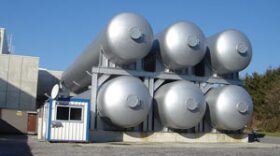A new report from the National Wildlife Federation outlines the effects of climate change for Michigan's big game animals and their habitat.
The report says deer, moose, and elk experience dire repercussions from human-induced climate change.
Christopher Hoving is the Wildlife Adaptation Specialist at the Michigan Department of Natural Resources. He says that a decrease of snowfall will affect the deer population locally and regionally.
Hoving also says that the disease Epizootic Hemorrhagic Disease, or EHD, found in white tailed deer, is more common thanks to longer summers and warmer winters.
From the report:
Nowhere to Run takes a comprehensive look at the best available science on climate change’s impacts on big game, covering moose, mule deer, white-tailed deer, elk, pronghorn, bighorn sheep and black bears. The most significant effects include: Heat: Moose can become heat-stressed in warm weather, especially in summer if temperatures climb above 60 to70 degrees when moose coats are thinner. Heat stress leads to lower weights, declining pregnancy rates and increased vulnerability to predators and disease. Because of warmer fall and winter temperatures, black bears are already more active than usual during times when they normally conserve energy through hibernation, pushing fat stores to the limit. Drought: More droughts have reduced aspen forests in the west, a favorite elk habitat, and many elk are not migrating as much as they traditionally have. Increasing periods of drought, more invasive plants and wildfires will alter sagebrush and grassland ecosystems, favored pronghorn habitats. Parasites and disease: With less snowpack to kill ticks, moose in New Hampshire are literally being eaten alive, losing so much blood to ticks that they die of anemia. White-tailed deer are susceptible to hemorrhagic disease caused by viruses transmitted by biting midges
Nowhere to Run outlines the key steps needed to stem climate change and save big game:
- Address the underlying cause and cut carbon pollution 50 percent by 2030.
- Transition to cleaner, more secure sources of energy like offshore wind, solar power and next-generation biofuels and avoid polluting energy like coal and tar sands oil.
- Safeguard wildlife and their habitats by promoting climate-smart approaches to conservation.
- Factor a changing climate in big game plans and management.
Read the report at NWF.org/Sportsmen. Nowhere to Run is the latest in the National Wildlife Federation’s 2013 Wildlife in a Warming World series:
- Wildlife in a Warming World: Confronting the Climate Crisis
- Shifting Skies: Migratory Birds in a Warming World
- Swimming Upstream: Freshwater Fish in a Warming World




